
How about this? Among the loudest “buzz” at Aero Friedrichshafen 2022 was the introduction of turbine engines on Light-Sport Aircraft. At least three well-known LSA producers are experimenting with turbines. OK, I know turbines are not allowed on present-day LSA. Could that be changing as Mosaic slowly works its way through the FAA? We won’t know until FAA releases their NPRM at this year’s Oshkosh (I predict). However, some language provided by the agency to guide ASTM standards writers has suggested that the ban on turbines might not last. A irony to this possibility is that turbines were the specific reason why electric wasn’t permitted. Uh… what?! Yep, in the effort to prevent turbines, FAA rule writers specified reciprocating engines only. That kept out turbines, alright, but it also scratched electric propulsion. Back in the early 2000s, government authorities weren’t pushing electric vehicles so rule writers didn’t feel the political pressure they do now.


 OK, I know turbines are not allowed on present-day LSA. Could that be changing as Mosaic slowly works its way through the FAA? We won't know until FAA releases their NPRM at this year's Oshkosh (I predict). However, some language provided by the agency to guide ASTM standards writers has suggested that the ban on turbines might not last.
OK, I know turbines are not allowed on present-day LSA. Could that be changing as Mosaic slowly works its way through the FAA? We won't know until FAA releases their NPRM at this year's Oshkosh (I predict). However, some language provided by the agency to guide ASTM standards writers has suggested that the ban on turbines might not last.
 A irony to this possibility is that turbines were the specific reason why electric wasn't permitted. Uh… what?! Yep, in the effort to prevent turbines, FAA rule writers specified reciprocating engines only. That kept out turbines, alright, but it also scratched electric propulsion. Back in the early 2000s, government authorities weren't pushing electric vehicles so rule writers didn't feel the political pressure they do now.
Of at least three companies displaying turbine engines (all use the same supplier; see below),
A irony to this possibility is that turbines were the specific reason why electric wasn't permitted. Uh… what?! Yep, in the effort to prevent turbines, FAA rule writers specified reciprocating engines only. That kept out turbines, alright, but it also scratched electric propulsion. Back in the early 2000s, government authorities weren't pushing electric vehicles so rule writers didn't feel the political pressure they do now.
Of at least three companies displaying turbine engines (all use the same supplier; see below),  "
" "Bristell B8 is an all-metal, high-wing [design] without struts and with a steerable nose wheel," said the company. Although it looks quite different from the low wing, B8's cockpit is equally spacious at 49.2 inches wide. Pilots and their cabin mates will no doubt find entry much easier than first climbing up on the wing. Generally, pilots identify as high or low wing enthusiasts and now BRM can offer them what they want.
While most of the aircraft is aluminum like the low wing B23 Bristell, B8's cockpit doors and the luggage compartment door are made from composite material. The landing gear appears to be the same as on the low wing B23.
The basic B8 model is powered by a 100-horsepower Rotax 912 ULS. At a later stage, BRM Aero "plans to develop options to fit the other
"Bristell B8 is an all-metal, high-wing [design] without struts and with a steerable nose wheel," said the company. Although it looks quite different from the low wing, B8's cockpit is equally spacious at 49.2 inches wide. Pilots and their cabin mates will no doubt find entry much easier than first climbing up on the wing. Generally, pilots identify as high or low wing enthusiasts and now BRM can offer them what they want.
While most of the aircraft is aluminum like the low wing B23 Bristell, B8's cockpit doors and the luggage compartment door are made from composite material. The landing gear appears to be the same as on the low wing B23.
The basic B8 model is powered by a 100-horsepower Rotax 912 ULS. At a later stage, BRM Aero "plans to develop options to fit the other  H55 is a leading enabler of electric aviation offering modular, lightweight, and certified electric propulsion and battery management solutions to the aviation industry as to make air transport, quiet, clean and affordable. "H55 supports its customers in integrating and customizing its technology solutions for a wide range of applications suitable for both existing airplane designs and future concepts such as VTOLs and e-commuter aircraft," said the Swiss company.
H55 is a leading enabler of electric aviation offering modular, lightweight, and certified electric propulsion and battery management solutions to the aviation industry as to make air transport, quiet, clean and affordable. "H55 supports its customers in integrating and customizing its technology solutions for a wide range of applications suitable for both existing airplane designs and future concepts such as VTOLs and e-commuter aircraft," said the Swiss company.
 The result? An electric LSA-style aircraft with a 419-pound payload, an 1,874-pound MTOW, a climb rate of 800 feet per minute, and electric energy cost for a one-hour flight of $7.00. Charging time for normal operations is reportedly just one hour. BRM Aero expects to achieve CS23 certification by mid-2022. It should be available for flight schools as soon as mid-2022, the company said.
"With the B23 Energic, our company has become a pioneer of the next aviation revolution," said BRM Aero. That may be so, but I'll bet we see more interest in the B8 high wing or — for the best-heeled customers — the turbine Bristell.
BRM Aero, based in the Czech Republic, was established in 2009. With seven models available today, BRM Aero produces more than 100 aircraft every year. "Bristell has produced more than 670 LSA aircraft worldwide," said the company.
The result? An electric LSA-style aircraft with a 419-pound payload, an 1,874-pound MTOW, a climb rate of 800 feet per minute, and electric energy cost for a one-hour flight of $7.00. Charging time for normal operations is reportedly just one hour. BRM Aero expects to achieve CS23 certification by mid-2022. It should be available for flight schools as soon as mid-2022, the company said.
"With the B23 Energic, our company has become a pioneer of the next aviation revolution," said BRM Aero. That may be so, but I'll bet we see more interest in the B8 high wing or — for the best-heeled customers — the turbine Bristell.
BRM Aero, based in the Czech Republic, was established in 2009. With seven models available today, BRM Aero produces more than 100 aircraft every year. "Bristell has produced more than 670 LSA aircraft worldwide," said the company.
 I elected not to go to what would have been my 27th visit to Aero because just two months ago, when I needed to make air reservations, Covid panic still gripped Europe. Officially in mid-February, the show could not even be held. It looked too questionable for me to go forward with costly tickets amid global uncertainty; I was unwilling to chance being quarantined for two weeks at my own expense. Challenges of obtaining the right Covid documents also proved difficult. Fortunately for the beleaguered Aero organizers, things opened up but now I'm missing one of my favorite airshows of the year. So, a big thanks to John Rathmell of
I elected not to go to what would have been my 27th visit to Aero because just two months ago, when I needed to make air reservations, Covid panic still gripped Europe. Officially in mid-February, the show could not even be held. It looked too questionable for me to go forward with costly tickets amid global uncertainty; I was unwilling to chance being quarantined for two weeks at my own expense. Challenges of obtaining the right Covid documents also proved difficult. Fortunately for the beleaguered Aero organizers, things opened up but now I'm missing one of my favorite airshows of the year. So, a big thanks to John Rathmell of  This promotional video from BRM shows the handsome lines of their new B8 high wing model debuted at Aero 2022. Note the forward sweep of the wings that should improve upward visibility from the cockpit.
https://youtu.be/11VaQjb3AHA
This promotional video from BRM shows the handsome lines of their new B8 high wing model debuted at Aero 2022. Note the forward sweep of the wings that should improve upward visibility from the cockpit.
https://youtu.be/11VaQjb3AHA


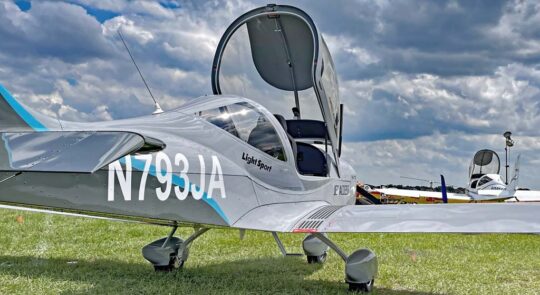





 I captured video from multiple cameras for each aircraft; watch for our video pilot report soon. While the video is in editing, I will give a short review of the Stream. This was a new experience for me.
As flown, TL's Stream is in Experimental-Exhibition category. That will suffice for a few examples, but the future involving Mosaic may be inviting for Stream, so the model could get a leg up on some competitors by establishing a U.S. presence before Mosaic becomes the governing regulation.
I captured video from multiple cameras for each aircraft; watch for our video pilot report soon. While the video is in editing, I will give a short review of the Stream. This was a new experience for me.
As flown, TL's Stream is in Experimental-Exhibition category. That will suffice for a few examples, but the future involving Mosaic may be inviting for Stream, so the model could get a leg up on some competitors by establishing a U.S. presence before Mosaic becomes the governing regulation.
 Up front instrumentation is larger and you do fly solo from the front. Yet in the back, I had a seven-inch Garmin touch screen that provided the same info in a smaller package. For example, the gear position shows in both locations… although, like most digital screens, it may take a while to pick out the data you want from all that is displayed.
The aft seat also has a full-featured joystick with buttons for elevator and aileron trim, push to talk and other functions. It has everything the front seat has so you can enjoy flying Stream from the back as much as the front.
Up front instrumentation is larger and you do fly solo from the front. Yet in the back, I had a seven-inch Garmin touch screen that provided the same info in a smaller package. For example, the gear position shows in both locations… although, like most digital screens, it may take a while to pick out the data you want from all that is displayed.
The aft seat also has a full-featured joystick with buttons for elevator and aileron trim, push to talk and other functions. It has everything the front seat has so you can enjoy flying Stream from the back as much as the front.
 However, in one way the front proves superior, regarding runway visibility on approach to landing. With no flaps or with one notch deployed, I had no sight picture from the aft seat. However, with full flaps, I could easily keep an eye on the runway. An offset to the aft seat visibility looking forward is that you have an excellent straight down view that the front PIC seat lacks; the pilot up front is seated at the wing midpoint so downward visibility is restricted.
However, in one way the front proves superior, regarding runway visibility on approach to landing. With no flaps or with one notch deployed, I had no sight picture from the aft seat. However, with full flaps, I could easily keep an eye on the runway. An offset to the aft seat visibility looking forward is that you have an excellent straight down view that the front PIC seat lacks; the pilot up front is seated at the wing midpoint so downward visibility is restricted.
 What you might be more surprised to learn is how gentle its stall characteristics are and how slow it can go on landing.
I asked Trey to demonstrate stalls and then did some myself and in every such trial Stream was as gentle in stall response as any aircraft in the LSA space. We were not particularly aggressive as this is a clean airplane and is unfamiliar to me, but we did several stalls and every one of them demonstrated extremely benign characteristics that resulted in virtually no nose drop stall break nor any wing wobble. This is remarkably convincing stability for any aircraft in the space but certainly one aimed at the performance end of the market.
What you might be more surprised to learn is how gentle its stall characteristics are and how slow it can go on landing.
I asked Trey to demonstrate stalls and then did some myself and in every such trial Stream was as gentle in stall response as any aircraft in the LSA space. We were not particularly aggressive as this is a clean airplane and is unfamiliar to me, but we did several stalls and every one of them demonstrated extremely benign characteristics that resulted in virtually no nose drop stall break nor any wing wobble. This is remarkably convincing stability for any aircraft in the space but certainly one aimed at the performance end of the market.
 Since I mentioned the aircraft speeds along quite well, I rush to say I was rather amazed that Stream could slow down into the high-30s (knots) when flaps are deployed. From 39 knots indicated to 150 knots in cruise, we start to approach that magic 4:1 stall-to-cruise target that any designer likes to achieve (it's not an easy mark to hit).
As we came into land and as Trey put down the flaps, I mentioned above that the site picture improves for the aft seat when flaps are fully deployed. They go down 40°, Troy said, so these are some fairly deep flaps. On initial deployment, flaps look ordinary and rather small; in the aft seat I had a clear view of flap operations. Then I observed the Fowler flap construction as the flaps continued to deploy. That's when you see how effective this construction can be.
I readily admit I was taken by surprise at the very slow speeds we achieved on landing. Trey says 400 feet of ground roll is achievable and it's possible to land even shorter with skill and correct use of the controls. I would have doubted this was possible had I not seen the excellent stall characteristics and how slow Stream could fly.
Since I mentioned the aircraft speeds along quite well, I rush to say I was rather amazed that Stream could slow down into the high-30s (knots) when flaps are deployed. From 39 knots indicated to 150 knots in cruise, we start to approach that magic 4:1 stall-to-cruise target that any designer likes to achieve (it's not an easy mark to hit).
As we came into land and as Trey put down the flaps, I mentioned above that the site picture improves for the aft seat when flaps are fully deployed. They go down 40°, Troy said, so these are some fairly deep flaps. On initial deployment, flaps look ordinary and rather small; in the aft seat I had a clear view of flap operations. Then I observed the Fowler flap construction as the flaps continued to deploy. That's when you see how effective this construction can be.
I readily admit I was taken by surprise at the very slow speeds we achieved on landing. Trey says 400 feet of ground roll is achievable and it's possible to land even shorter with skill and correct use of the controls. I would have doubted this was possible had I not seen the excellent stall characteristics and how slow Stream could fly.
 Then, through a series of turns, I discovered that Stream will hold its altitude very well without power or trim adjustments of any kind. Of course, using those controls will make handling even better I suspect, but stick pressures remained light and it was simply unnecessary to employ those controls in order to produce turns that maintained altitude and speed. These are wonderful characteristics for Stream to demonstrate.
Back on the ground I again took the controls and found taxi steering to be responsive, further amplified by directional braking that that assures maneuvering on a ramp will be easy.
Then, through a series of turns, I discovered that Stream will hold its altitude very well without power or trim adjustments of any kind. Of course, using those controls will make handling even better I suspect, but stick pressures remained light and it was simply unnecessary to employ those controls in order to produce turns that maintained altitude and speed. These are wonderful characteristics for Stream to demonstrate.
Back on the ground I again took the controls and found taxi steering to be responsive, further amplified by directional braking that that assures maneuvering on a ramp will be easy.


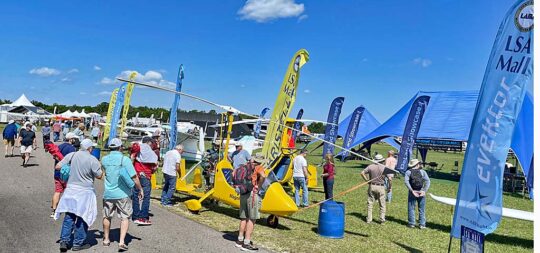
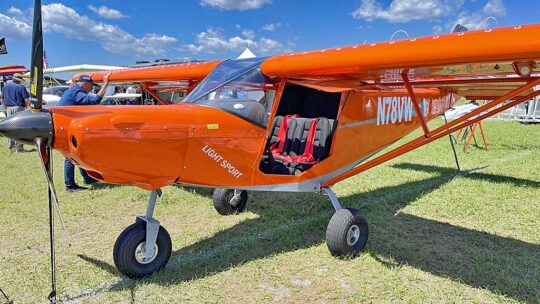




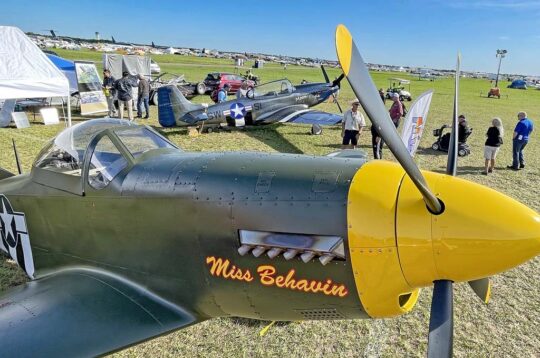 One such example is a fascinating collaboration, in this case between two companies each producing a substantially authentic scale model replica of the famous World War II fighter. One has a market established over several years. The other has a spectacular new entry. How can you imagine the story ends?
Surprise! They decide to work together.
One such example is a fascinating collaboration, in this case between two companies each producing a substantially authentic scale model replica of the famous World War II fighter. One has a market established over several years. The other has a spectacular new entry. How can you imagine the story ends?
Surprise! They decide to work together.
 Christian von Kessel of
Christian von Kessel of  As
As  Ron showed active work on the project as they unveiled their new nose cowling at Sun 'n Fun. If you look at the earlier article you'll see they've made a quality upgrade. This happened when an automobile industry engineer with an interest in airplanes offered to assist Thunderbird. He was able to employ his skills including use of an auto company wind tunnel to refine the shape. As the nearby images show, the work reveals professional quality; the shape is excellent. Will it be all done by AirVenture Oshkosh 2022? No, but it'll be coming along this year, Ron is sure.
Ron showed active work on the project as they unveiled their new nose cowling at Sun 'n Fun. If you look at the earlier article you'll see they've made a quality upgrade. This happened when an automobile industry engineer with an interest in airplanes offered to assist Thunderbird. He was able to employ his skills including use of an auto company wind tunnel to refine the shape. As the nearby images show, the work reveals professional quality; the shape is excellent. Will it be all done by AirVenture Oshkosh 2022? No, but it'll be coming along this year, Ron is sure.
 "Hummingbird is an innovative project designed and manufactured by Hummingbird Industria Aeronautica and distributed in North America by
"Hummingbird is an innovative project designed and manufactured by Hummingbird Industria Aeronautica and distributed in North America by  They promote reasonable prices: the two-seater around $75,000 and a single seater around $40,000 (but contact the company for current prices; shipping costs are at crazy levels). The two seat tandem model we saw at Sun 'n Fun had the
They promote reasonable prices: the two-seater around $75,000 and a single seater around $40,000 (but contact the company for current prices; shipping costs are at crazy levels). The two seat tandem model we saw at Sun 'n Fun had the 
 On pleasant evenings, crowds can be five deep all along the runway fence. STOL comps provide exciting close-up action. At few other airports can you observe so closely, literally 100 feet away from runway centerline.
After the main afternoon airshow aerobatic acts conclude, you can do one of two things. You can go to the car park and wait in long lines to get out of the lot or you can make your way to the Ultralight Area / Lightplane Area / or Paradise City and catch the evening STOL comps. When they're done competing, the car parks are moving better and you'll waste less time sitting in line.
STOL comps were planned every evening of Sun 'n Fun but 20 mile per hour winds blowing 90° cross to the runway over a nearby line of tress was a bit much for many competitors. For two days, we've had limited flying in Paradise City.
On pleasant evenings, crowds can be five deep all along the runway fence. STOL comps provide exciting close-up action. At few other airports can you observe so closely, literally 100 feet away from runway centerline.
After the main afternoon airshow aerobatic acts conclude, you can do one of two things. You can go to the car park and wait in long lines to get out of the lot or you can make your way to the Ultralight Area / Lightplane Area / or Paradise City and catch the evening STOL comps. When they're done competing, the car parks are moving better and you'll waste less time sitting in line.
STOL comps were planned every evening of Sun 'n Fun but 20 mile per hour winds blowing 90° cross to the runway over a nearby line of tress was a bit much for many competitors. For two days, we've had limited flying in Paradise City.
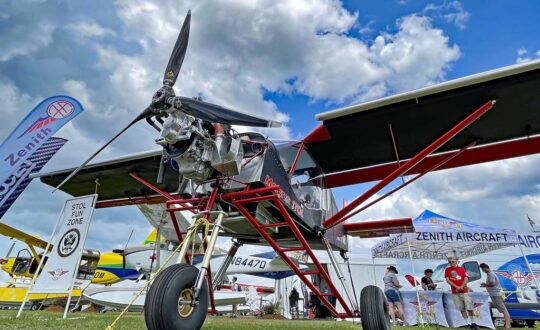 Unfortunately Steve broke an axle and ended up on his nose in Wednesdays gusty conditions. Damage was reasonably minor — an advantage of landing so slowly perhaps — and he should be back in action soon.
His is not the only aircraft designed specifically to win STOL comps.
Unfortunately Steve broke an axle and ended up on his nose in Wednesdays gusty conditions. Damage was reasonably minor — an advantage of landing so slowly perhaps — and he should be back in action soon.
His is not the only aircraft designed specifically to win STOL comps.
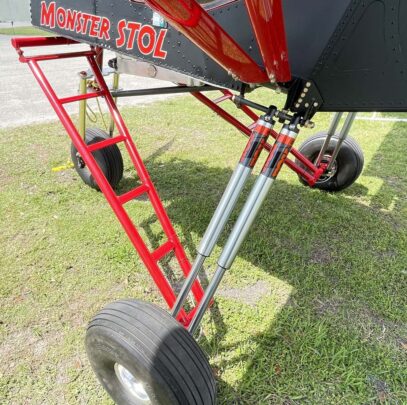
 Monster STOL solves that problem, Jan believes. His dual aft shocks on each side have 18 inches of stroke. The tires aren't tundra but they're large. And standing Super Duty up on specialized landing gear — which also helps entry into this high-off-the-ground airplane — allows Jan to create a very steep angle of attack.
"I already get off the surface in 44 feet," said Jan in a video interview you'll see later. He wants to do even better and to further shorten his landings. The super beefy gear arrangement will let him plop the aircraft on the ground in the shortest possible distance.
"It's fun and a little whacky," said Sebastien Heintz of
Monster STOL solves that problem, Jan believes. His dual aft shocks on each side have 18 inches of stroke. The tires aren't tundra but they're large. And standing Super Duty up on specialized landing gear — which also helps entry into this high-off-the-ground airplane — allows Jan to create a very steep angle of attack.
"I already get off the surface in 44 feet," said Jan in a video interview you'll see later. He wants to do even better and to further shorten his landings. The super beefy gear arrangement will let him plop the aircraft on the ground in the shortest possible distance.
"It's fun and a little whacky," said Sebastien Heintz of 

 Little did we know last year that Putin would invade Ukraine and plunge both countries into disarray. The
Little did we know last year that Putin would invade Ukraine and plunge both countries into disarray. The 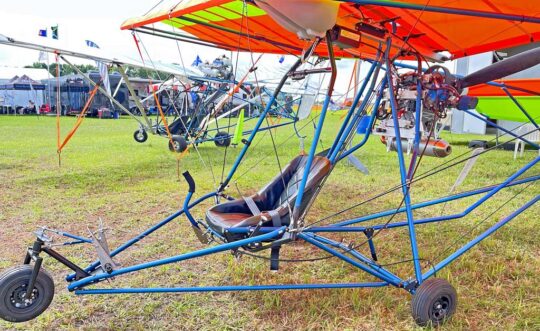 At Sun 'n Fun 2022, Gene "Bever" Borne and son Ken of
At Sun 'n Fun 2022, Gene "Bever" Borne and son Ken of  Upon closer inspection, this Sprint model was powered by Aero 1000, a single-cylinder, four-stroke engine with impressive specs. Air-Tech said it outputs 39 horsepower — similar to the Rotax 447 — and is extremely economical on fuel.
"It also has a great sound," said Ken Borne in our video interview about the engine.
How does a small displacement engine (250 cc) get that kind of power from one cylinder? Part of the magic is high revolutions. "This engine runs at 9200 rpm." said Ken. The engine idles at 1800-2000 rpm, he added.
Is Aero 1000 a creation of Air-Tech, Inc., the longtime Quicksilver representative that now owns the rights? No, they didn't originate this. That effort was done by Mike Robinson, owner and CEO of
Upon closer inspection, this Sprint model was powered by Aero 1000, a single-cylinder, four-stroke engine with impressive specs. Air-Tech said it outputs 39 horsepower — similar to the Rotax 447 — and is extremely economical on fuel.
"It also has a great sound," said Ken Borne in our video interview about the engine.
How does a small displacement engine (250 cc) get that kind of power from one cylinder? Part of the magic is high revolutions. "This engine runs at 9200 rpm." said Ken. The engine idles at 1800-2000 rpm, he added.
Is Aero 1000 a creation of Air-Tech, Inc., the longtime Quicksilver representative that now owns the rights? No, they didn't originate this. That effort was done by Mike Robinson, owner and CEO of 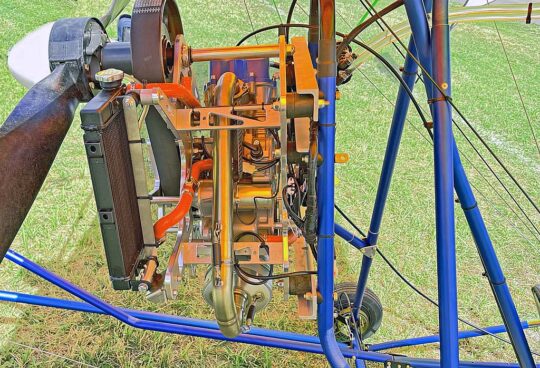 Blackhawk's search for the right engine for their quads lead them to an Swiss engine popular with cart racing enthusiasts. These racers push the engines hard and after years of working to improve the breed, the base engine has become very reliable.
Blackhawk later created a mount construction for the engine to be used on their quads.
Bever and Ken noticed this development at AirVenture Oshkosh where the two companies have side-by-side display spaces. They got to talking as vendors do at airshows. After Mike said some of his paraglider customers wanted to investigate fixed wing flying, Bever and Mike struck an agreement to try out the Blackhawk configuration on their Quicksilver line.
Bever said the final installed weight of the Aero 1000 with reduction drive and exhaust and all other components is about 15 pounds more than the Rotax 447 with its driveshaft and other hardware. Most pilots will readily give up 15 pounds of useful load to have four-stroke reliability and reduced noise.
Blackhawk's search for the right engine for their quads lead them to an Swiss engine popular with cart racing enthusiasts. These racers push the engines hard and after years of working to improve the breed, the base engine has become very reliable.
Blackhawk later created a mount construction for the engine to be used on their quads.
Bever and Ken noticed this development at AirVenture Oshkosh where the two companies have side-by-side display spaces. They got to talking as vendors do at airshows. After Mike said some of his paraglider customers wanted to investigate fixed wing flying, Bever and Mike struck an agreement to try out the Blackhawk configuration on their Quicksilver line.
Bever said the final installed weight of the Aero 1000 with reduction drive and exhaust and all other components is about 15 pounds more than the Rotax 447 with its driveshaft and other hardware. Most pilots will readily give up 15 pounds of useful load to have four-stroke reliability and reduced noise.
 Bever and Ken have fitted the Aero 1000 to their Sprint after building fairly simple hardware to support the engine — see nearby photos of engine and mounts.
When I asked if this particular aircraft with the Aero 1000 powering it honestly stays within Part 103 limits, Ken responded without hesitation, "Yes, it does."
While Air-Tech conducts flight testing of the Sprint with Aero 1000,
Bever and Ken have fitted the Aero 1000 to their Sprint after building fairly simple hardware to support the engine — see nearby photos of engine and mounts.
When I asked if this particular aircraft with the Aero 1000 powering it honestly stays within Part 103 limits, Ken responded without hesitation, "Yes, it does."
While Air-Tech conducts flight testing of the Sprint with Aero 1000, 
 After we got the LSA Mall set up to receive a flock of airplanes, I was able to get around the sprawling Sun 'n Fun campus to see what else I planned to cover as the show begins. It starts Tuesday the 5th and runs through Sunday the 10th. I hope you can make it but if not, I'll be reporting on the aircraft that I think may interest you.
One extra treat — for me and for you: my YouTube partner, Videoman Dave has been able to escape Canada and turned up at Sun 'n Fun. We'll return to our usual drill of roving around doing video interviews. I'm happy as Dave is highly knowledgeable about the same kind of aircraft I report and we've learned to work well together, making somewhere approaching 1,000 videos. You are happy as
After we got the LSA Mall set up to receive a flock of airplanes, I was able to get around the sprawling Sun 'n Fun campus to see what else I planned to cover as the show begins. It starts Tuesday the 5th and runs through Sunday the 10th. I hope you can make it but if not, I'll be reporting on the aircraft that I think may interest you.
One extra treat — for me and for you: my YouTube partner, Videoman Dave has been able to escape Canada and turned up at Sun 'n Fun. We'll return to our usual drill of roving around doing video interviews. I'm happy as Dave is highly knowledgeable about the same kind of aircraft I report and we've learned to work well together, making somewhere approaching 1,000 videos. You are happy as  Now represented in the USA, Bat Hawk travel traveled half way around the globe to get to Sun 'n Fun. This side-by-side two seater has well established itself in South Africa but will now test interest from Americans. Based on rave reviews from those with experience, the odds look promising.
Some say this is looks like a… fill-in-the-blank, usually a reference to an ultralight such as Flightstar or Quicksilver. It is neither, having been developed over some years in the Southern Hemisphere nation but it is born of an earlier generation.
We're hoping to interview Bat Hawk America's Gary Saitowitz or one of his team at Sun 'n Fun and then I'll have more. Meanwhile,
Now represented in the USA, Bat Hawk travel traveled half way around the globe to get to Sun 'n Fun. This side-by-side two seater has well established itself in South Africa but will now test interest from Americans. Based on rave reviews from those with experience, the odds look promising.
Some say this is looks like a… fill-in-the-blank, usually a reference to an ultralight such as Flightstar or Quicksilver. It is neither, having been developed over some years in the Southern Hemisphere nation but it is born of an earlier generation.
We're hoping to interview Bat Hawk America's Gary Saitowitz or one of his team at Sun 'n Fun and then I'll have more. Meanwhile,  One company has focused for years on creating replicas for famous designs harking back to World War I, a time not long after the Wright Brothers first flew their Flyer on the sand dunes of Kitty Hawk. We're talking century-old designs, created with slide rules and drafting pape and not much prior art on which to rely.
In
One company has focused for years on creating replicas for famous designs harking back to World War I, a time not long after the Wright Brothers first flew their Flyer on the sand dunes of Kitty Hawk. We're talking century-old designs, created with slide rules and drafting pape and not much prior art on which to rely.
In  Replicas are big business in cars, boats, and, of course airplanes. Some like Airdrome cater to one era of history enthusiasts. Others cater to a later war period. Scalewings goes to great effort to make these designs as authentic as possible while building at around 50% of original scale. The task is impressive, enough so that most of us have no real idea of the detail that is goes into something like the model in the photos.
I have written about ScaleBirds, their P-36 project, and the radial engines they enjoy using. However, I probably cannot do them the justice they deserve. I hope you can swing by their space in the main or "core" are of Sun 'n Fun but
Replicas are big business in cars, boats, and, of course airplanes. Some like Airdrome cater to one era of history enthusiasts. Others cater to a later war period. Scalewings goes to great effort to make these designs as authentic as possible while building at around 50% of original scale. The task is impressive, enough so that most of us have no real idea of the detail that is goes into something like the model in the photos.
I have written about ScaleBirds, their P-36 project, and the radial engines they enjoy using. However, I probably cannot do them the justice they deserve. I hope you can swing by their space in the main or "core" are of Sun 'n Fun but  One of my favorites to come along in the second decade of Light-Sport Aircraft is the
One of my favorites to come along in the second decade of Light-Sport Aircraft is the  I didn't get to visit with anyone from The Airplane Factory on set-up day to hear if they have any late-breaking news — so I'll go back, of course — but the sharpest paint job I found anywhere on the grounds was the handsome Sling 4 seen nearby. I have reported on Sling LSA and
I didn't get to visit with anyone from The Airplane Factory on set-up day to hear if they have any late-breaking news — so I'll go back, of course — but the sharpest paint job I found anywhere on the grounds was the handsome Sling 4 seen nearby. I have reported on Sling LSA and  If AeroSport sounds busy (and they are!),
If AeroSport sounds busy (and they are!),  To close this preview article so I can go to bed and get ready to do this all again tomorrow, I want to extend a thank you on behalf of myself and
To close this preview article so I can go to bed and get ready to do this all again tomorrow, I want to extend a thank you on behalf of myself and 
 Lead by company namesake, Paul Vickers, Wave has been a work in process for eleven years. All along Paul has been saying he would get it right on the first flight and it looks like he succeeded.
He also said that the methods he followed to get this far would speed production significantly. He means that when this airplane would take its first flight, it would not be some cobbled-together, proof-of-concept aircraft. The Wave that just flew should also go very directly into production without the need for another long round of engineering. Look at the images and the video. This looks like a factory production model, not a crude prototype still rough around the edges.
Lead by company namesake, Paul Vickers, Wave has been a work in process for eleven years. All along Paul has been saying he would get it right on the first flight and it looks like he succeeded.
He also said that the methods he followed to get this far would speed production significantly. He means that when this airplane would take its first flight, it would not be some cobbled-together, proof-of-concept aircraft. The Wave that just flew should also go very directly into production without the need for another long round of engineering. Look at the images and the video. This looks like a factory production model, not a crude prototype still rough around the edges.
 "While much of the aircraft is as it will be in final production, the interior and landing gear are purely functional, allowing us to refine and perfect these areas," explained Paul. As you see in the list below, Wave promises landing gear unlike any other seaplane. "After a series of further test flights, we will be removing the undercarriage and commencing the much-anticipated water testing," said Paul. "Once we have completed the water testing, we will be fitting our revolutionary undercarriage."
As the Vickers team observed and as the video appears to show, Wave flew well as soon as it got airborne for the first time.
"While much of the aircraft is as it will be in final production, the interior and landing gear are purely functional, allowing us to refine and perfect these areas," explained Paul. As you see in the list below, Wave promises landing gear unlike any other seaplane. "After a series of further test flights, we will be removing the undercarriage and commencing the much-anticipated water testing," said Paul. "Once we have completed the water testing, we will be fitting our revolutionary undercarriage."
As the Vickers team observed and as the video appears to show, Wave flew well as soon as it got airborne for the first time.
 "Seeing how stable Wave was in flight is a true testament to taking the time to get things right," Paul felt. "Always having 'safety' as the key driver for every decision has proven to be an incredibly fundamental corner stone for the Wave project; from who we hire to our suppliers and hardware, safety has led our decisions."
Along the way, Vickers has looked at different engines but the New Zealand group settled on the
"Seeing how stable Wave was in flight is a true testament to taking the time to get things right," Paul felt. "Always having 'safety' as the key driver for every decision has proven to be an incredibly fundamental corner stone for the Wave project; from who we hire to our suppliers and hardware, safety has led our decisions."
Along the way, Vickers has looked at different engines but the New Zealand group settled on the  For avionics in the test aircraft as well as in later production aircraft, Vickers had selected Dynon. Other systems will also be offered.
"Dynon stepped up very early in our program and have been an incredible support during the installation and system checks, all of which were seamless," Paul said. "
For avionics in the test aircraft as well as in later production aircraft, Vickers had selected Dynon. Other systems will also be offered.
"Dynon stepped up very early in our program and have been an incredible support during the installation and system checks, all of which were seamless," Paul said. " "Of all the light airplanes I have flown, Wave is now and by far my favorite," said Paco. "Paul and his team have done a spectacular job designing and building Wave. It was an honor and privilege to conduct the first flight. I can’t wait to fly Wave again."
"The design team are well on the way to firming up the remaining areas to be productionized," finished Paul, "while the production team is looking at increasing capacity and forward ordering required materials."
Congratulations to the Vickers team for taking the time to get it right and for completing a successful first flight, a momentous achievement for any clean-sheet design such as Wave.
"Of all the light airplanes I have flown, Wave is now and by far my favorite," said Paco. "Paul and his team have done a spectacular job designing and building Wave. It was an honor and privilege to conduct the first flight. I can’t wait to fly Wave again."
"The design team are well on the way to firming up the remaining areas to be productionized," finished Paul, "while the production team is looking at increasing capacity and forward ordering required materials."
Congratulations to the Vickers team for taking the time to get it right and for completing a successful first flight, a momentous achievement for any clean-sheet design such as Wave.
 For those curious about weight exemptions for Light-Sport Aircraft — Wave is the fourth such weight exemption granted. Before them came exemptions for 1,680 pounds and 1,800 pounds (the latter for Terrafugia and SkyRunner. At 1,850 pounds, Wave is the new high-water mark but not by much. Under the coming Mosaic rule, these exemptions may no longer be necessary.
Visitors to
For those curious about weight exemptions for Light-Sport Aircraft — Wave is the fourth such weight exemption granted. Before them came exemptions for 1,680 pounds and 1,800 pounds (the latter for Terrafugia and SkyRunner. At 1,850 pounds, Wave is the new high-water mark but not by much. Under the coming Mosaic rule, these exemptions may no longer be necessary.
Visitors to 
 "It is the best of the several models of LSA that Zlin has ever made," SportairUSA boss, Bill Canino said of Norden.
He proudly announced that Norden received its FAA certificate of airworthiness as a Special LSA. SportairUSA is the distributor and service center for Savage and other sport aircraft in the USA.
Because the first customer's Norden was used to gain FAA acceptance as a Special LSA (that included logging 20 hours), the owner is understandably anxious to receive his new bird so SportairUSA will not be attending
"It is the best of the several models of LSA that Zlin has ever made," SportairUSA boss, Bill Canino said of Norden.
He proudly announced that Norden received its FAA certificate of airworthiness as a Special LSA. SportairUSA is the distributor and service center for Savage and other sport aircraft in the USA.
Because the first customer's Norden was used to gain FAA acceptance as a Special LSA (that included logging 20 hours), the owner is understandably anxious to receive his new bird so SportairUSA will not be attending  About two years ago,
About two years ago,  Bill worked with FAA representatives to gain acceptance during the fall and winter of 2021-22. “We appreciate the attention to safety that the FAA brings to this process,” said Canino, whose company, SportairUSA, has been a pioneer in the field of Light-Sport Aircraft, serving the experimental and recreational aviation community since 1990.
Bill worked with FAA representatives to gain acceptance during the fall and winter of 2021-22. “We appreciate the attention to safety that the FAA brings to this process,” said Canino, whose company, SportairUSA, has been a pioneer in the field of Light-Sport Aircraft, serving the experimental and recreational aviation community since 1990. "The design of Norden incorporates classic short takeoff and landing (STOL) elements together with innovative concepts tested and proved in previous Zlin products," said Bill. "Pilot feedback, from the Alaskan bush to the deserts of South Africa, played an important role in Zlin’s evolution as a designer and manufacturer of STOL aircraft."
"The design of Norden incorporates classic short takeoff and landing (STOL) elements together with innovative concepts tested and proved in previous Zlin products," said Bill. "Pilot feedback, from the Alaskan bush to the deserts of South Africa, played an important role in Zlin’s evolution as a designer and manufacturer of STOL aircraft." According to Zlin’s founder, Pasquale Russo, “The design target was to offer to the market a new version of our plane with improved STOL performance and with these main characteristics: full metal wing, electrically-operated retractable slats, double slotted flaps, extended range, optimized cruise and low-speed flight characteristics, a wide flight envelope and low pilot workload.” (See extensive feature list below.)
According to Zlin’s founder, Pasquale Russo, “The design target was to offer to the market a new version of our plane with improved STOL performance and with these main characteristics: full metal wing, electrically-operated retractable slats, double slotted flaps, extended range, optimized cruise and low-speed flight characteristics, a wide flight envelope and low pilot workload.” (See extensive feature list below.)


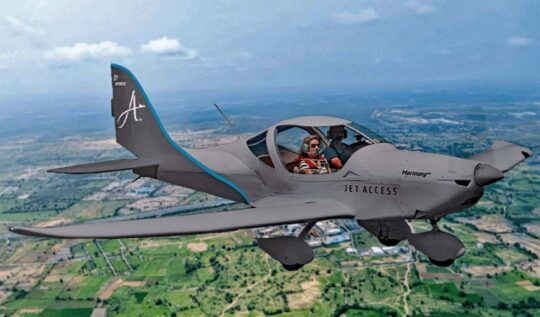 The legal issue is not the subject of this article, but now that the matter has successfully been resolved, the Czech producer is back in action and raring to go.
For the three U.S.-based representatives — Steve Minnich's
The legal issue is not the subject of this article, but now that the matter has successfully been resolved, the Czech producer is back in action and raring to go.
For the three U.S.-based representatives — Steve Minnich's 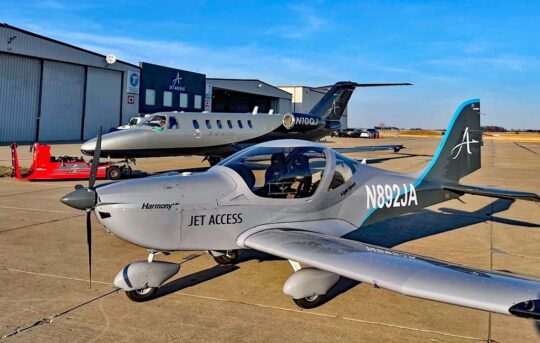 Jet Access
Jet Access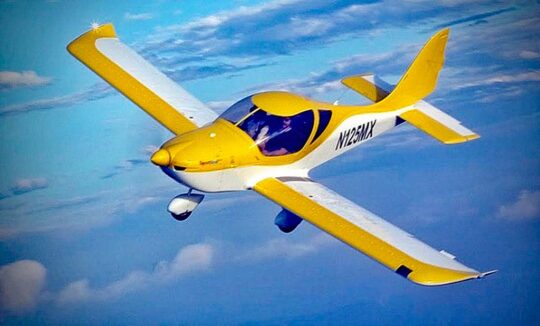 John Mauch, Jet Access' Chief Flight Instructor and Director of Operations said, "We are the 10th largest charter in the world based on flight hours. Jet Access is the only vertically integrated aviation enterprise at a national scale. We do charter, Part 91 jet management, brokerage, FBO management, full service Part 145 MRO, Part 61 and 141 flight training with collegiate program management."
"Headquartered in Indianapolis, Jet Access has chosen Evektor for the same reason organizations have chosen primary trainers for the last 100 years: they are two-place, light and frisky, durable, easy-to-fly and maintain, with a high dispatch rate, plus low fuel burn and operating costs," explained west coast rep', Steve Treretola.
John Mauch, Jet Access' Chief Flight Instructor and Director of Operations said, "We are the 10th largest charter in the world based on flight hours. Jet Access is the only vertically integrated aviation enterprise at a national scale. We do charter, Part 91 jet management, brokerage, FBO management, full service Part 145 MRO, Part 61 and 141 flight training with collegiate program management."
"Headquartered in Indianapolis, Jet Access has chosen Evektor for the same reason organizations have chosen primary trainers for the last 100 years: they are two-place, light and frisky, durable, easy-to-fly and maintain, with a high dispatch rate, plus low fuel burn and operating costs," explained west coast rep', Steve Treretola.
 "The Evektors are technically advanced aircraft with glass cockpits and autopilots," echoed John. He added, "This prepares our students for modern piloting that improves safety, while still focusing on stick and rudder skills due to flight characteristics of the Evektors. They’re also larger inside than legacy trainers with far better visibility and cabin airflow." With airplanes Jet Access has on order for Q3 2022 delivery, they will operate about 80 aircraft, the company elaborated.
John Mauch is an ATP instructor with experience in Cessna, Piper, and Cirrus models. He instructed for Larry Gehrig's
"The Evektors are technically advanced aircraft with glass cockpits and autopilots," echoed John. He added, "This prepares our students for modern piloting that improves safety, while still focusing on stick and rudder skills due to flight characteristics of the Evektors. They’re also larger inside than legacy trainers with far better visibility and cabin airflow." With airplanes Jet Access has on order for Q3 2022 delivery, they will operate about 80 aircraft, the company elaborated.
John Mauch is an ATP instructor with experience in Cessna, Piper, and Cirrus models. He instructed for Larry Gehrig's  "The Evektor fleet has amassed over one million flight hours," Steve Treretola added. "Evektor is built using traditional metal construction, has a fuel burn of four gallons per hour, and has a 2,000-hour engine TBO making it an ideal 21st century successor to the famous trainers of the past including the ubiquitous Cessna 150 and 152 plus the Piper Cherokee series."
Treretola observed that Jet Access chief pilot, John Mauch has amassed several thousand hours instructing in Evektor Harmony and knows the brand well. "With that experience, Jet Access felt comfortable placing an initial order for a dozen Harmony aircraft and has optioned a total of 100 [with delivery] spread out over a number of years," Steve reported.
"The Evektor fleet has amassed over one million flight hours," Steve Treretola added. "Evektor is built using traditional metal construction, has a fuel burn of four gallons per hour, and has a 2,000-hour engine TBO making it an ideal 21st century successor to the famous trainers of the past including the ubiquitous Cessna 150 and 152 plus the Piper Cherokee series."
Treretola observed that Jet Access chief pilot, John Mauch has amassed several thousand hours instructing in Evektor Harmony and knows the brand well. "With that experience, Jet Access felt comfortable placing an initial order for a dozen Harmony aircraft and has optioned a total of 100 [with delivery] spread out over a number of years," Steve reported.
 Evektor has gone far beyond LSA with their four seat Super Cobra (nearby photo) developed some years ago and a twin-engine turboprop regional airliner called EV-55 Outback. These are far outside my coverage of aviation but show the depth of experience and knowledge within Evektor.
Years ago I visited their factory in Kunovice, Czech to see them building the SportStar LSA. It was an impressive facility and the region is highly aviation oriented so an abundance of talented workers is available. Evektor is also very active in design and development work for the automotive industry.
I hope to see you at
Evektor has gone far beyond LSA with their four seat Super Cobra (nearby photo) developed some years ago and a twin-engine turboprop regional airliner called EV-55 Outback. These are far outside my coverage of aviation but show the depth of experience and knowledge within Evektor.
Years ago I visited their factory in Kunovice, Czech to see them building the SportStar LSA. It was an impressive facility and the region is highly aviation oriented so an abundance of talented workers is available. Evektor is also very active in design and development work for the automotive industry.
I hope to see you at 
 I can remember firsthand when one of aviation's true characters — Chuck Slusaczyk, of Chuck's Glider Supplies or CGS — brought his first Hawk to Sun 'n Fun. As this article illustrates, that was 40 years ago!
Yes, fellow fun flyers, 2022 is the year aviation celebrates the 40th anniversary of Part 103 and the emergence of the "ultralight vehicle."
One of the ground-breaking designs that year (1982) was the CGS Hawk. When Chuck introduced this flying machine, he broke some of the rules and went on to sell more than 2,500 of the popular series. What rules did he break?
I can remember firsthand when one of aviation's true characters — Chuck Slusaczyk, of Chuck's Glider Supplies or CGS — brought his first Hawk to Sun 'n Fun. As this article illustrates, that was 40 years ago!
Yes, fellow fun flyers, 2022 is the year aviation celebrates the 40th anniversary of Part 103 and the emergence of the "ultralight vehicle."
One of the ground-breaking designs that year (1982) was the CGS Hawk. When Chuck introduced this flying machine, he broke some of the rules and went on to sell more than 2,500 of the popular series. What rules did he break?
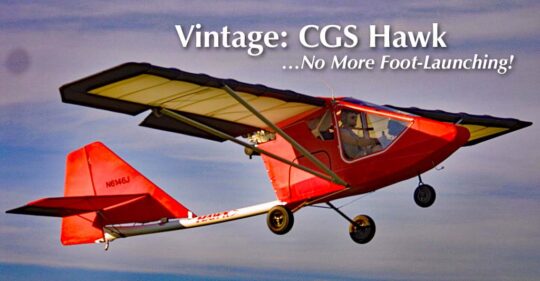

 A longtime friend of the Slusarczyk family, Tim was bound and determined to save Hawk #1 from disintegrating in the Florida sun. "As I understand it," Bob said, "Tim negotiated with the Museum staff to acquire Hawk #1, so long as it was never flown again, and Tim's intention was to move the plane to his personal hangar in Florida, with plans for a future renovation."
Bob continued, "After the acquisition, Tim and Laura moved to Tennessee and took Hawk #1 with them, storing it in Tim's rented hangar, again with the intention of renovating her someday.
A longtime friend of the Slusarczyk family, Tim was bound and determined to save Hawk #1 from disintegrating in the Florida sun. "As I understand it," Bob said, "Tim negotiated with the Museum staff to acquire Hawk #1, so long as it was never flown again, and Tim's intention was to move the plane to his personal hangar in Florida, with plans for a future renovation."
Bob continued, "After the acquisition, Tim and Laura moved to Tennessee and took Hawk #1 with them, storing it in Tim's rented hangar, again with the intention of renovating her someday.
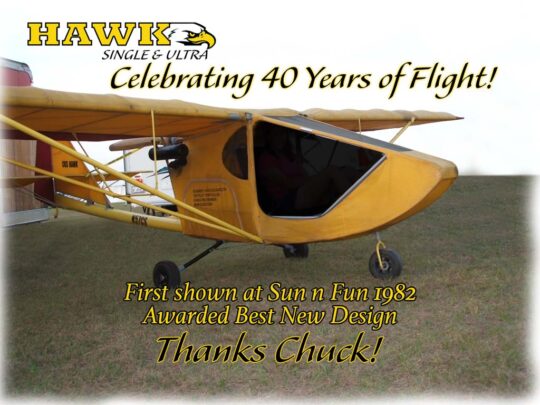 "Unfortunately, and tragically, Tim was killed in a light aircraft crash on September 10, 2020, in Sweetwater, Tennessee. Laura was not able to keep the hangar and moved Hawk #1 to a barn at her home.
"Since Tim and Laura were longtime Hawk fans," Bob remembered, "our paths crossed after we acquired the single seat and ultralight manufacturing rights. Conversations ensued about how most everyone believed that Hawk #1 was a very important and historical airplane, worthy of preservation. As [one of] the first true three-axis ultralight-type flying machines that literally and positively changed our industry for many years to come, restoring #1 is a tribute to Chuck as well as all of the Hawk faithful."
"Via mutual Hawk enthusiasts and after spending time with Laura, we bought Hawk #1 and transported her back to our shop in Port St. Lucie, Florida," explained Bob.
"Unfortunately, and tragically, Tim was killed in a light aircraft crash on September 10, 2020, in Sweetwater, Tennessee. Laura was not able to keep the hangar and moved Hawk #1 to a barn at her home.
"Since Tim and Laura were longtime Hawk fans," Bob remembered, "our paths crossed after we acquired the single seat and ultralight manufacturing rights. Conversations ensued about how most everyone believed that Hawk #1 was a very important and historical airplane, worthy of preservation. As [one of] the first true three-axis ultralight-type flying machines that literally and positively changed our industry for many years to come, restoring #1 is a tribute to Chuck as well as all of the Hawk faithful."
"Via mutual Hawk enthusiasts and after spending time with Laura, we bought Hawk #1 and transported her back to our shop in Port St. Lucie, Florida," explained Bob.


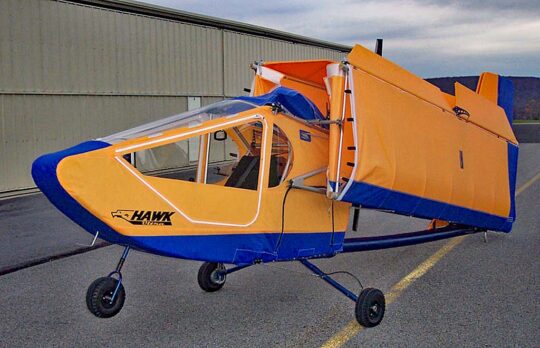

 Most of us, including your author, tend to fly only fully-built aircraft while another group of equal size enjoys the building process — or at least this is a more affordable path to airplane ownership.
Roger truly enjoys his '650 on which he mounted a potent 130-horsepower
Most of us, including your author, tend to fly only fully-built aircraft while another group of equal size enjoys the building process — or at least this is a more affordable path to airplane ownership.
Roger truly enjoys his '650 on which he mounted a potent 130-horsepower 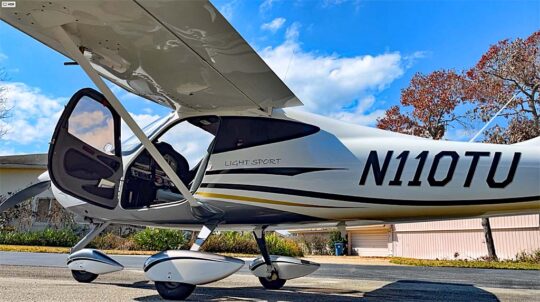 With a whole stable of handsome aircraft —
With a whole stable of handsome aircraft —  Although Roger scored a superbly-equipped, low-time P2008 (and paid a bit more for it), at least one other for sale, a 2009 model is asking $117,500 in early 2022. Honestly, a used example is a way many pilots could acquire one of these sharp airplanes.
Roger is a LSR-M LSA mechanic. Open the engine compartment doors and you'll see an engine so clean and tidy it looks like it has never been run. If you have the mechanical aptitude and training Roger has, your airplane ownership can be much more affordable. (Note that Roger also does maintenance work on the
Although Roger scored a superbly-equipped, low-time P2008 (and paid a bit more for it), at least one other for sale, a 2009 model is asking $117,500 in early 2022. Honestly, a used example is a way many pilots could acquire one of these sharp airplanes.
Roger is a LSR-M LSA mechanic. Open the engine compartment doors and you'll see an engine so clean and tidy it looks like it has never been run. If you have the mechanical aptitude and training Roger has, your airplane ownership can be much more affordable. (Note that Roger also does maintenance work on the  Tecnam's wing for the sleek P2008 is fairly conventional constant-chord shape except for a pinching at the wingroot/fuselage junction. Outboard, the trailing edge is gently tapered with slightly upturned wing tips. Frise ailerons span the outboard sections with discreet slotted flaps inboard. A single lift strut on each side braces the wings to the lower fuselage. On its tail P2008 has a stabilator-style constant-chord tailplane. Its vertical fin is gracefully swept.
Although Roger's P2008 has the turbo 914 engine, most P2008s are powered by Rotax's 912ULS. While Roger's P2008 has a three-blade prop, most models come with a two-blade propeller.
Cloth-covered seats match a fully-appointed interior that bares no metal or composite, hiding all linkages out of sight. An aft baggage space can hold 44 pounds. For P2008, Tecnam engineers enlarged both the cabin and doors aiding entry and exit and making your time aboard more comfortable. Either seat can be moved fore and aft at any time.
Fixed tricycle gear uses spring cantilever main legs and a castoring, non-steerable nosewheel with compressed rubber suspension. You steer on the ground using differential braking.
P2008's first flight took place September 30, 2008 and the first P2008 was delivered to the U.S. in December 2009.
Tecnam's wing for the sleek P2008 is fairly conventional constant-chord shape except for a pinching at the wingroot/fuselage junction. Outboard, the trailing edge is gently tapered with slightly upturned wing tips. Frise ailerons span the outboard sections with discreet slotted flaps inboard. A single lift strut on each side braces the wings to the lower fuselage. On its tail P2008 has a stabilator-style constant-chord tailplane. Its vertical fin is gracefully swept.
Although Roger's P2008 has the turbo 914 engine, most P2008s are powered by Rotax's 912ULS. While Roger's P2008 has a three-blade prop, most models come with a two-blade propeller.
Cloth-covered seats match a fully-appointed interior that bares no metal or composite, hiding all linkages out of sight. An aft baggage space can hold 44 pounds. For P2008, Tecnam engineers enlarged both the cabin and doors aiding entry and exit and making your time aboard more comfortable. Either seat can be moved fore and aft at any time.
Fixed tricycle gear uses spring cantilever main legs and a castoring, non-steerable nosewheel with compressed rubber suspension. You steer on the ground using differential braking.
P2008's first flight took place September 30, 2008 and the first P2008 was delivered to the U.S. in December 2009.
 All Tecnam models are revered for their "natural" handling. This is one of the most straightforward-flying LSA in the fleet. It can function as a capable cross country aircraft or could be used in flight training, though probably not with the turbocharged Rotax 914.
In my flight, the turbocharger added a very noticeable boost to depart the runway and enhances initial climb rate generously. We saw more than 1,200 feet per minute at near-sea-level operation. When you increase power, a detent you can feel with your throttle hand alerts you that the turbo is about to be engaged. After five minutes of use — enough to get to 5,000 feet or so — you need to back off the turbo but could employ it again for enroute climb or operations at very high elevation airports. While a more complex installation with somewhat higher maintenance needs, Roger says the 914 is quite easy to operate.
No wonder Tecnam has risen to be the largest builder of very light aircraft. If you are in the market for a luxury-class LSA, a P2008 on the used market could be your next airplane.
All Tecnam models are revered for their "natural" handling. This is one of the most straightforward-flying LSA in the fleet. It can function as a capable cross country aircraft or could be used in flight training, though probably not with the turbocharged Rotax 914.
In my flight, the turbocharger added a very noticeable boost to depart the runway and enhances initial climb rate generously. We saw more than 1,200 feet per minute at near-sea-level operation. When you increase power, a detent you can feel with your throttle hand alerts you that the turbo is about to be engaged. After five minutes of use — enough to get to 5,000 feet or so — you need to back off the turbo but could employ it again for enroute climb or operations at very high elevation airports. While a more complex installation with somewhat higher maintenance needs, Roger says the 914 is quite easy to operate.
No wonder Tecnam has risen to be the largest builder of very light aircraft. If you are in the market for a luxury-class LSA, a P2008 on the used market could be your next airplane.



 When you fly solo you can operate your flying machine the way you want — well… within the laws of physics and the laws of FAA (or whatever national CAA you must obey). What you don't need to do is worry about a passenger.
Single place aircraft are commonly much more affordable.
Despite following single place aircraft closely, even I have been astounded at steadily increasing interest in single place aircraft over the last few years. Although significantly out of sight of many aviators, single place aviation has been growing faster than you imagine. Some pilots actually think Part 103 "died" a couple decades back. I don't know how it feels to be that wrong, but they are.
Most of these single place aircraft are Part 103 vehicles but not all, not by a long shot.
When you fly solo you can operate your flying machine the way you want — well… within the laws of physics and the laws of FAA (or whatever national CAA you must obey). What you don't need to do is worry about a passenger.
Single place aircraft are commonly much more affordable.
Despite following single place aircraft closely, even I have been astounded at steadily increasing interest in single place aircraft over the last few years. Although significantly out of sight of many aviators, single place aviation has been growing faster than you imagine. Some pilots actually think Part 103 "died" a couple decades back. I don't know how it feels to be that wrong, but they are.
Most of these single place aircraft are Part 103 vehicles but not all, not by a long shot.
 As of late 2021, we began included kit-built Part 103-type aircraft in our
As of late 2021, we began included kit-built Part 103-type aircraft in our 

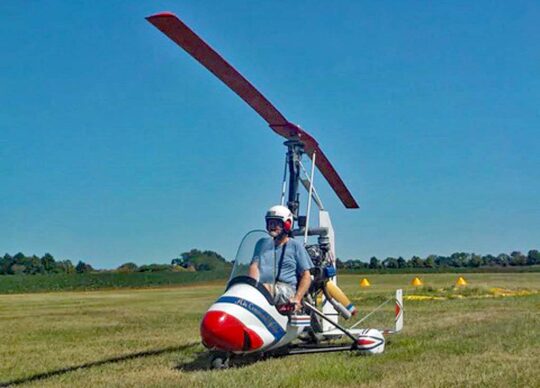

 The Skywheels rotor system is being manufactured again following an 18-year production hiatus. "The Skywheels name has a loyal pilot following with a performance and safety record dating back to 1985.," reported Joe.
The rotor blade chord is 8-inches wide, is offered in multiple lengths, and offers two different style tips: square or swept. The color options include Air Command red, bright white, plus custom colors.
The Skywheels rotor system is being manufactured again following an 18-year production hiatus. "The Skywheels name has a loyal pilot following with a performance and safety record dating back to 1985.," reported Joe.
The rotor blade chord is 8-inches wide, is offered in multiple lengths, and offers two different style tips: square or swept. The color options include Air Command red, bright white, plus custom colors.
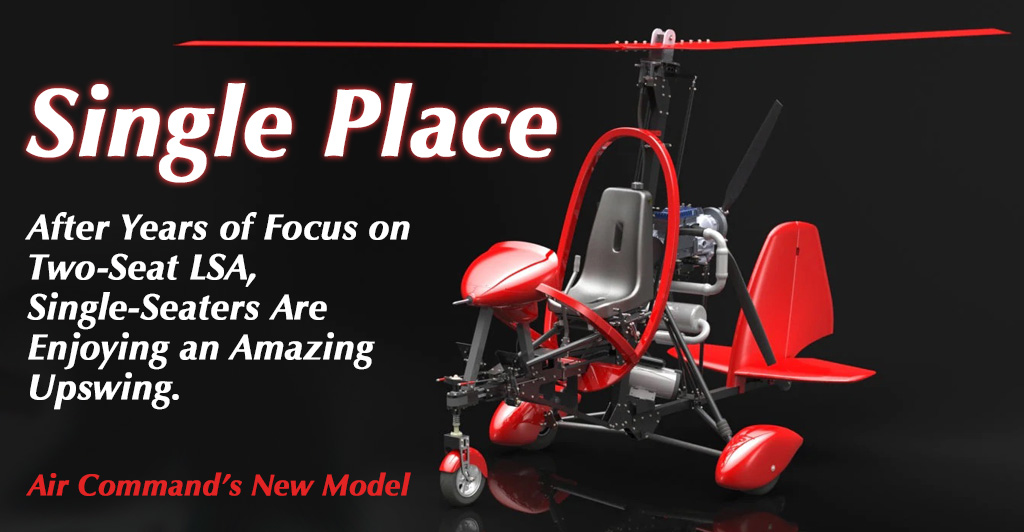
 Both airplane producer stories made it into mainstream media.
If we go way back in time, to 2003, that is, before Light-Sport Aircraft, we saw a world where Americans flew kit-built airplanes while European pilots were flying what they called ultralights or microlights. Of course, this is an oversimplification but we had no idea the two methods of production would converge as they have in the last two decades.
Using widely-accepted consensus standards, Light-Sport Aircraft can operate in multiple countries — thanks to the useful work of many volunteers that assembled and maintain ASTM standards embraced by FAA and other CAAs all over the planet.
Let's look at these two stories…
Both airplane producer stories made it into mainstream media.
If we go way back in time, to 2003, that is, before Light-Sport Aircraft, we saw a world where Americans flew kit-built airplanes while European pilots were flying what they called ultralights or microlights. Of course, this is an oversimplification but we had no idea the two methods of production would converge as they have in the last two decades.
Using widely-accepted consensus standards, Light-Sport Aircraft can operate in multiple countries — thanks to the useful work of many volunteers that assembled and maintain ASTM standards embraced by FAA and other CAAs all over the planet.
Let's look at these two stories…


 “At this point, there are about 10 to 12 airframes at the Kherson plant,” Peghiny said to AOPA. "Ordinarily, the airframes would be sent to Flight Design’s final assembly and completion center in the city of Šumperk in the Czech Republic."
“We’ve found a new, 25,000-square-foot site [in Šumperk that is] suitable for use as a production and paint shop, and will use that in the future,” Peghiny said in the AOPA article. Engineering work is also conducted in Šumperk.
"Flight Design is offering to move its Ukraine staff and their families to the Šumperk facility," AOPA wrote. "Peghiny said that the Kherson plant will function as long as conditions allow. However, tooling currently remaining in Kherson will have to be replaced by newly manufactured tooling for use in Šumperk. The company will fund new tooling, but it may take six to nine months to build."
“At this point, there are about 10 to 12 airframes at the Kherson plant,” Peghiny said to AOPA. "Ordinarily, the airframes would be sent to Flight Design’s final assembly and completion center in the city of Šumperk in the Czech Republic."
“We’ve found a new, 25,000-square-foot site [in Šumperk that is] suitable for use as a production and paint shop, and will use that in the future,” Peghiny said in the AOPA article. Engineering work is also conducted in Šumperk.
"Flight Design is offering to move its Ukraine staff and their families to the Šumperk facility," AOPA wrote. "Peghiny said that the Kherson plant will function as long as conditions allow. However, tooling currently remaining in Kherson will have to be replaced by newly manufactured tooling for use in Šumperk. The company will fund new tooling, but it may take six to nine months to build."

 "Flight Design employs just under 200 technicians, assemblers, and engineers currently at the Kherson plant," continued Boatman, "and according to Peghiny, the company has been ramping up that number. 'We were hiring more aggressively in the past year because of the popularity of the F2, but the other models in the range have been selling well in Europe — simpler, lighter models in particular,' Tom said." Of course, Tom refers to the CT-series including CTLS that is one of the most popular LSA in America.
“We know [our employees] very well,” Peghiny said in Boatman's article. “Some have been with the company more than 20 years. We’re good friends, and we take this very personally.”
"Flight Design employs just under 200 technicians, assemblers, and engineers currently at the Kherson plant," continued Boatman, "and according to Peghiny, the company has been ramping up that number. 'We were hiring more aggressively in the past year because of the popularity of the F2, but the other models in the range have been selling well in Europe — simpler, lighter models in particular,' Tom said." Of course, Tom refers to the CT-series including CTLS that is one of the most popular LSA in America.
“We know [our employees] very well,” Peghiny said in Boatman's article. “Some have been with the company more than 20 years. We’re good friends, and we take this very personally.”
 Dave Hirschman wrote, "Dennis Long, a dealer for Aeroprakt… said he spoke with factory officials who said they plan to remain on the job. 'They told me they’re going to keep making airplanes until they can’t'," AOPA reported. 'For the time being, it’s business as usual, although my next two airplanes will likely have to be shipped from Poland because the port of Odessa [in Ukraine] is closed.'”
Aeroprakt has steady registered more aircraft with the FAA. When asked by AOPA's writer, Dennis said, "Right now, due to all the uncertainty, I’m not taking any new deposits. I’m more concerned about the people over there than the airplanes at this moment."
Dave Hirschman wrote, "Dennis Long, a dealer for Aeroprakt… said he spoke with factory officials who said they plan to remain on the job. 'They told me they’re going to keep making airplanes until they can’t'," AOPA reported. 'For the time being, it’s business as usual, although my next two airplanes will likely have to be shipped from Poland because the port of Odessa [in Ukraine] is closed.'”
Aeroprakt has steady registered more aircraft with the FAA. When asked by AOPA's writer, Dennis said, "Right now, due to all the uncertainty, I’m not taking any new deposits. I’m more concerned about the people over there than the airplanes at this moment."

 Many others might never shut down the engine and soar but are intrigued with efficient cross country flying. In a motorglider, a pilot can be more confident as the aircraft can glide far further than other types, providing a broader safety margin.
From a one-man operation comes the Italian
Many others might never shut down the engine and soar but are intrigued with efficient cross country flying. In a motorglider, a pilot can be more confident as the aircraft can glide far further than other types, providing a broader safety margin.
From a one-man operation comes the Italian  If
If  Readers who want to save money acquiring a motorglider may finally have a good option: the Piuma Project — composed of five models, the Original, Evolution, Tourer, Twin Evolution, and Almerico. The latter two are two seaters, though Tiziano admits his primary interest is the single place model.
"The first idea was to design, to build and to fly a little one seat ultralight motorglider, for personal use, very safe in flight, simple in the construction, and easy to pilot,” said Tiziano. "I wanted it to have flight characteristics and comfort higher than various tube-and-fabric ultralights of that time." (This was at the end of the '80s.)
Readers who want to save money acquiring a motorglider may finally have a good option: the Piuma Project — composed of five models, the Original, Evolution, Tourer, Twin Evolution, and Almerico. The latter two are two seaters, though Tiziano admits his primary interest is the single place model.
"The first idea was to design, to build and to fly a little one seat ultralight motorglider, for personal use, very safe in flight, simple in the construction, and easy to pilot,” said Tiziano. "I wanted it to have flight characteristics and comfort higher than various tube-and-fabric ultralights of that time." (This was at the end of the '80s.)
 The first flights of the Piuma Original date back to 1990. This was followed with the Tourer.
The first flights of the Piuma Original date back to 1990. This was followed with the Tourer.
 A Piuma Tourer confirmed the suitability of the name by flying from Venice to Sicily one year (1,250 kilometers or 776 miles) and from Venice to Paris another year (900 kilometers or 560 miles). These flights confirm, Tiziano said, "that even with a small motorglider, I can do great trips."
He has also designed and drawn two-seater versions: the Piuma Twin, later replaced with the Piuma Twin Evolution, that incorporates all the improvements suggested during nine years of Piuma Twin construction: a 20 centimeter (8 inch) longer front fuselage, for better balance without ballast and a rear fuselage similar to the single seat Piuma Evolution.
The designer's interest and that of many potential buyer/builder may remain with the single seat models. Not only will they be less costly but with only a single seat, pilots need only satisfy themselves.
A Piuma Tourer confirmed the suitability of the name by flying from Venice to Sicily one year (1,250 kilometers or 776 miles) and from Venice to Paris another year (900 kilometers or 560 miles). These flights confirm, Tiziano said, "that even with a small motorglider, I can do great trips."
He has also designed and drawn two-seater versions: the Piuma Twin, later replaced with the Piuma Twin Evolution, that incorporates all the improvements suggested during nine years of Piuma Twin construction: a 20 centimeter (8 inch) longer front fuselage, for better balance without ballast and a rear fuselage similar to the single seat Piuma Evolution.
The designer's interest and that of many potential buyer/builder may remain with the single seat models. Not only will they be less costly but with only a single seat, pilots need only satisfy themselves.
 “Construction time depends on the builder's meticulousness,” said Tiziano. “Normally, about 1,000 hours are sufficient for a person with limited woodworking experience to complete the work. Plans are composed of large technical sheets (24 x 40 inches) with lots of details.”
“Some component elements require the use of a lathe and/or milling machine, but most of the construction may be built without special tools. It is very easy,” said Tiziano. He completed his Piuma Original after 18 months of work, in a two-car garage measuring 21 feet long and 13.2 feet wide.
Drawings show multiple views and have all the details. A "Construction Book" is provided with instructions and references to the drawings that explain more details relating to each model. Drawings and the book also note all the materials to be purchased specifying the quantity and quality of each necessary element, from the aviation birch plywood to the aluminum alloy parts and including Dacron fabric, glues, and more.
“Construction time depends on the builder's meticulousness,” said Tiziano. “Normally, about 1,000 hours are sufficient for a person with limited woodworking experience to complete the work. Plans are composed of large technical sheets (24 x 40 inches) with lots of details.”
“Some component elements require the use of a lathe and/or milling machine, but most of the construction may be built without special tools. It is very easy,” said Tiziano. He completed his Piuma Original after 18 months of work, in a two-car garage measuring 21 feet long and 13.2 feet wide.
Drawings show multiple views and have all the details. A "Construction Book" is provided with instructions and references to the drawings that explain more details relating to each model. Drawings and the book also note all the materials to be purchased specifying the quantity and quality of each necessary element, from the aviation birch plywood to the aluminum alloy parts and including Dacron fabric, glues, and more.
 A "Project Book" is not necessary for the normal builder, but it is very important for those who want to know the project better. The Project Book contains design considerations; lots of drawings of the fuselage, wings, tail, and more; structural calculations; plus flying characteristics and speeds.
The construction plan set sells for $200-$400 (each model is somewhat different in price) in early 2022. Tiziano reported, "The cost of materials, excluding engine and instruments, is around $4,000 (at 2020 prices).”
Based on that number my guesstimate for total price with a used Rotax two-stroke engine, basic analog instruments, and minimal paint might be $15,000 or less.
A "Project Book" is not necessary for the normal builder, but it is very important for those who want to know the project better. The Project Book contains design considerations; lots of drawings of the fuselage, wings, tail, and more; structural calculations; plus flying characteristics and speeds.
The construction plan set sells for $200-$400 (each model is somewhat different in price) in early 2022. Tiziano reported, "The cost of materials, excluding engine and instruments, is around $4,000 (at 2020 prices).”
Based on that number my guesstimate for total price with a used Rotax two-stroke engine, basic analog instruments, and minimal paint might be $15,000 or less.
 Professional build centers have been highlighted as one of Mosaic’s many aspects. Everyone including FAA recognizes that kits built with oversight from people who know the aircraft and the process of construction makes for better, safer airplanes. Because safety is FAA's main consideration, professional builder-assist centers are expected to part of the new regulation. I have been predicting we will see the NPRM by Oshkosh 2022 (mere months away now).
Professional build centers have been highlighted as one of Mosaic’s many aspects. Everyone including FAA recognizes that kits built with oversight from people who know the aircraft and the process of construction makes for better, safer airplanes. Because safety is FAA's main consideration, professional builder-assist centers are expected to part of the new regulation. I have been predicting we will see the NPRM by Oshkosh 2022 (mere months away now).
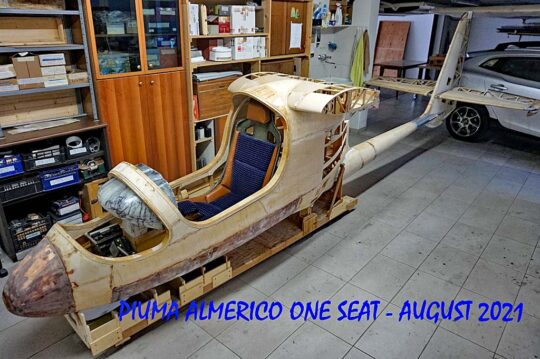



 Beside importing aircraft to the USA and helping customers build them, Chip experimented with
Beside importing aircraft to the USA and helping customers build them, Chip experimented with  Zigolo Mg21 starts out with multiple versions, mainly differences in wings and wing controls.
Since beginning in 2007, Francesco has delivered more than 50 aircraft to 16 countries and the new model looks to be a solid upgrade from the Mg12.
Aviad's three variations address different national regulations. The short-wing version is currently being tested. That will work in Europe, but will be too fast in some countries, such as the USA. A longer wing version will follow — and may be appreciated by those searching for a modestly-priced motorglider. Finally, a longer-wing version with flaps is planned for the American market to fit properly in Part 103. All versions have a single wing strut and will lose much of the wire bracing that helped keep Mg12 so very light.
Zigolo Mg21 starts out with multiple versions, mainly differences in wings and wing controls.
Since beginning in 2007, Francesco has delivered more than 50 aircraft to 16 countries and the new model looks to be a solid upgrade from the Mg12.
Aviad's three variations address different national regulations. The short-wing version is currently being tested. That will work in Europe, but will be too fast in some countries, such as the USA. A longer wing version will follow — and may be appreciated by those searching for a modestly-priced motorglider. Finally, a longer-wing version with flaps is planned for the American market to fit properly in Part 103. All versions have a single wing strut and will lose much of the wire bracing that helped keep Mg12 so very light.
 Mg21's central structure is a lower box beam running from an aerodynamically-shaped nose containing a digital instrument panel to a tubular empennage boom. In the center of the structure, two rectangular box-section beams support a fixed center wing section and the engine.
As nearby images show, this new Mg21 model has wings that can be folded "by one person in less than two minutes," according to a report in
Mg21's central structure is a lower box beam running from an aerodynamically-shaped nose containing a digital instrument panel to a tubular empennage boom. In the center of the structure, two rectangular box-section beams support a fixed center wing section and the engine.
As nearby images show, this new Mg21 model has wings that can be folded "by one person in less than two minutes," according to a report in  Flight testing is ongoing but stall speeds are estimated at 63 kilometers per hour or 34 knots for the short wing, 60 km/h (32 knots) for the long wing, and 52 km/h (28 knots) for the long wing with flap. Francesco will need to slow it another 4 knots to meet
Flight testing is ongoing but stall speeds are estimated at 63 kilometers per hour or 34 knots for the short wing, 60 km/h (32 knots) for the long wing, and 52 km/h (28 knots) for the long wing with flap. Francesco will need to slow it another 4 knots to meet  "For the USA market, I’m sure we can have a 55 knot cruise speed with climb at 800-900 feet per minute plus the easy-fold system (nearby photo), and a competitive price for an advanced [quick-build-type] kit. Due to very small pack size, we can use air shipment. I’m working with DHL to have worldwide fast shipment without the expensive container charges. I worked very hard to keep all measures inside the maximum permitted by DHL" Given numerous reports of container shipment costs rising by double, triple, or even more, air shipment might ironically turn out to be cheaper for such a cleverly-packaged product.
Francesco added, "I prefer Mg21 as a taildragger, but I'm studying a tricycle-gear version."
"All production will be managed internally from my workshop," observed Francesco. "We can fabricate all components."
"For the USA market, I’m sure we can have a 55 knot cruise speed with climb at 800-900 feet per minute plus the easy-fold system (nearby photo), and a competitive price for an advanced [quick-build-type] kit. Due to very small pack size, we can use air shipment. I’m working with DHL to have worldwide fast shipment without the expensive container charges. I worked very hard to keep all measures inside the maximum permitted by DHL" Given numerous reports of container shipment costs rising by double, triple, or even more, air shipment might ironically turn out to be cheaper for such a cleverly-packaged product.
Francesco added, "I prefer Mg21 as a taildragger, but I'm studying a tricycle-gear version."
"All production will be managed internally from my workshop," observed Francesco. "We can fabricate all components."
 "Accessories, engine, and instruments are included in the kit but will be shipped separately," said Francesco. "A customer will receive the airframe kit with all necessary to start the work, and a second shipment will bring the accessories.
"Accessories, engine, and instruments are included in the kit but will be shipped separately," said Francesco. "A customer will receive the airframe kit with all necessary to start the work, and a second shipment will bring the accessories.
 Please keep in mind these prices are subject to change given supply problems affecting all industries. "In any case, I will state an offering price for each batch of airplanes because the prices change on all materials," said Francesco. A first batch of 10 kits will be offered at close to the prices mentioned above but
Please keep in mind these prices are subject to change given supply problems affecting all industries. "In any case, I will state an offering price for each batch of airplanes because the prices change on all materials," said Francesco. A first batch of 10 kits will be offered at close to the prices mentioned above but 
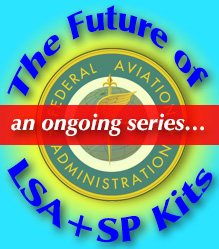 I still would not follow one multicopter article with another except for developer Doron Merdinger, saying this, "Suggested [selling price is] $135,000 to $150,000." That got my attention. From what I've seen so far, any eVTOL larger/heavier than a Part 103 entry is way, way more expensive.
Beyond that come air taxies… 4-6-8 seater urban air transport aircraft. Those I will never report as they are commercial by design and cost far beyond any Sport Pilot's budget. In addition, it could be years before they actually enter the market.
I still would not follow one multicopter article with another except for developer Doron Merdinger, saying this, "Suggested [selling price is] $135,000 to $150,000." That got my attention. From what I've seen so far, any eVTOL larger/heavier than a Part 103 entry is way, way more expensive.
Beyond that come air taxies… 4-6-8 seater urban air transport aircraft. Those I will never report as they are commercial by design and cost far beyond any Sport Pilot's budget. In addition, it could be years before they actually enter the market.
 No one commenting on Jetson One or the other Part 103
No one commenting on Jetson One or the other Part 103 
 Safety is addressed with features such as: programmed emergency landing protocols, an energy-dissipating body, multiple redundancies, air bag, ballistic parachute, and multiple anti-collision sensors. H1 is, Doroni explains, "a smart vehicle with advanced electronics, GPS, laser [range finders], cameras, a barometer, and accelerometers."
Doroni Aerospace is "expected to complete construction of a full-scale prototype by June 2022, with a view to starting flight testing by the end of the year," wrote FutureFlight.aero.
A major difference between the usual multicopter and Doroni is the ducted fan design.
Safety is addressed with features such as: programmed emergency landing protocols, an energy-dissipating body, multiple redundancies, air bag, ballistic parachute, and multiple anti-collision sensors. H1 is, Doroni explains, "a smart vehicle with advanced electronics, GPS, laser [range finders], cameras, a barometer, and accelerometers."
Doroni Aerospace is "expected to complete construction of a full-scale prototype by June 2022, with a view to starting flight testing by the end of the year," wrote FutureFlight.aero.
A major difference between the usual multicopter and Doroni is the ducted fan design.
 Ducted fans are also quieter than propellers: they shield the blade noise and reduce the intensity of the tip vortices. This is important for neighbor relations (especially when your unusual aircraft will also attract more than a usual share of attention).
Here's a big point in favor of Doroni's use of ducting: Ducted fans can allow for a limited amount of thrust vectoring, something for which normal propellers are not well suited.
Ducted fans are also quieter than propellers: they shield the blade noise and reduce the intensity of the tip vortices. This is important for neighbor relations (especially when your unusual aircraft will also attract more than a usual share of attention).
Here's a big point in favor of Doroni's use of ducting: Ducted fans can allow for a limited amount of thrust vectoring, something for which normal propellers are not well suited.


 In this article, I'll explore only such aircraft that might be called recreational. Interestingly, these developers have discovered Part 103 and are using it to get their aircraft to market. Like them or not, you have to admit these people are creative and driven. We should expect to see more of this.
Indeed, people who might buy one of these aircraft could conceivably outnumber all current-day pilots. So, as my clickbait title asks, "Are we Sport Pilots an endangered species?"
"We aim to make the skies available for everyone with our safe personal electric aerial vehicle," writes the producer. "We intend to make everyone a pilot." Are you good with that? Millions of new pilots? You could be the minority. Or maybe not. Future history cannot be written yet.
In this article, I'll explore only such aircraft that might be called recreational. Interestingly, these developers have discovered Part 103 and are using it to get their aircraft to market. Like them or not, you have to admit these people are creative and driven. We should expect to see more of this.
Indeed, people who might buy one of these aircraft could conceivably outnumber all current-day pilots. So, as my clickbait title asks, "Are we Sport Pilots an endangered species?"
"We aim to make the skies available for everyone with our safe personal electric aerial vehicle," writes the producer. "We intend to make everyone a pilot." Are you good with that? Millions of new pilots? You could be the minority. Or maybe not. Future history cannot be written yet.
 Reports
Reports 
 "The elementary design features an open chassis that means the Jetson One is only suitable for operations in fair weather conditions. It has eight sets of electric motors and rotors, and is fitted with a whole-aircraft recovery parachute," wrote FutureFlight.aero.
"We aim to make the skies available for everyone with our safe personal electric aerial vehicle," say the two developers. "Jetson One [is] a commercially available personal electric aerial vehicle that you can own and fly."
"The elementary design features an open chassis that means the Jetson One is only suitable for operations in fair weather conditions. It has eight sets of electric motors and rotors, and is fitted with a whole-aircraft recovery parachute," wrote FutureFlight.aero.
"We aim to make the skies available for everyone with our safe personal electric aerial vehicle," say the two developers. "Jetson One [is] a commercially available personal electric aerial vehicle that you can own and fly."
 If you want to join what may be millions of teen-aged boys on their smartphones, here's a link to a whole series of videos on Jetson One:
If you want to join what may be millions of teen-aged boys on their smartphones, here's a link to a whole series of videos on Jetson One: 
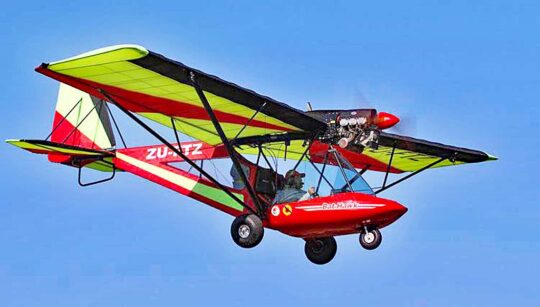 Bat Hawk is a well-established, conventional microlight-style light aircraft powered by a Rotax 912 that helps it provide "sensational" performance.
Bat Hawk is a well-established, conventional microlight-style light aircraft powered by a Rotax 912 that helps it provide "sensational" performance.
 Such working duties should not surprise anyone since
Such working duties should not surprise anyone since  Bat Hawk's engine and prop are mounted in a tractor position at wing level. Its tailplane is conventional in location and layout. Tricycle gear has a steerable nose-wheel. Bat Hawk's wing is strut- and lift-wire braced. Once common, wire bracing has largely disappeared from fixed wing but it remains a very strong configuration.
Bat Hawk's wing is built around two larger aluminum tubes forming the spars, one at the leading edge and one at the rear edge of the wing as is very common of aircraft with this construction. Sewn Dacron sailcloth covers all wing and tail surfaces plus the aft cockpit fairing.
Bat Hawk uses full-span flaperons attached to the rear spar; flaperons work independently as ailerons and together as flaps. There is no flap position indicator but approximate settings can be determined from the flap selector angle. Maximum flap movement is restricted by a limit stop mounted on the flap lever quadrant.
Bat Hawk's engine and prop are mounted in a tractor position at wing level. Its tailplane is conventional in location and layout. Tricycle gear has a steerable nose-wheel. Bat Hawk's wing is strut- and lift-wire braced. Once common, wire bracing has largely disappeared from fixed wing but it remains a very strong configuration.
Bat Hawk's wing is built around two larger aluminum tubes forming the spars, one at the leading edge and one at the rear edge of the wing as is very common of aircraft with this construction. Sewn Dacron sailcloth covers all wing and tail surfaces plus the aft cockpit fairing.
Bat Hawk uses full-span flaperons attached to the rear spar; flaperons work independently as ailerons and together as flaps. There is no flap position indicator but approximate settings can be determined from the flap selector angle. Maximum flap movement is restricted by a limit stop mounted on the flap lever quadrant.
 Side by side seating offers full dual control based on a center stick that no doubt makes entry a bit easier. Bat Hawk's rudder is actuated by cables running from the pedals. Ailerons are controlled by cables from a torque tube connected to the central control stick, which has a built-in control stop. The elevator is actuated by a push/pull cable attached directly to the control stick with built-in stops.
Manufacturer Micro Aviation said a wide track undercarriage has the main wheels supported by an inverted ‘V’ shaped glass fiber that provides suspension. Bat Hawk's nose wheel is supported by two hydraulic shock absorbers that "allows Bat Hawk to operate on rough terrain." Black Max disc brakes are actuated using a hand lever on the control stick. Differential braking is not available.
Side by side seating offers full dual control based on a center stick that no doubt makes entry a bit easier. Bat Hawk's rudder is actuated by cables running from the pedals. Ailerons are controlled by cables from a torque tube connected to the central control stick, which has a built-in control stop. The elevator is actuated by a push/pull cable attached directly to the control stick with built-in stops.
Manufacturer Micro Aviation said a wide track undercarriage has the main wheels supported by an inverted ‘V’ shaped glass fiber that provides suspension. Bat Hawk's nose wheel is supported by two hydraulic shock absorbers that "allows Bat Hawk to operate on rough terrain." Black Max disc brakes are actuated using a hand lever on the control stick. Differential braking is not available.
 Instrumentation is provided by an also South African MGL EMS (sold and serviced in America by
Instrumentation is provided by an also South African MGL EMS (sold and serviced in America by  For more info, Bathawk in America is finishing their new website, so email importer,
For more info, Bathawk in America is finishing their new website, so email importer, 